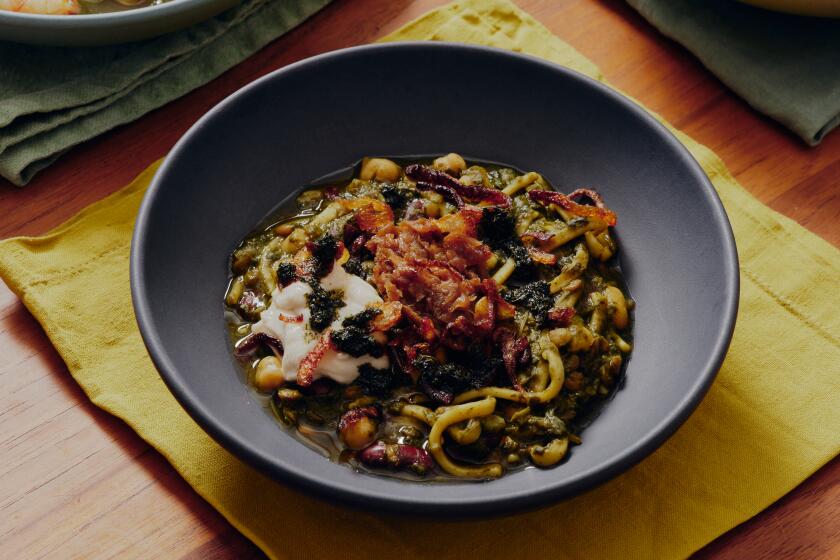Noodle kugel with mushrooms and sour cream
- Share via
A holiday to celebrate cheese sounds like a French idea. But it is Shavuot, the upcoming Jewish festival, that highlights dairy foods. The official purpose of the two-day holiday, which begins on Sunday evening, is to commemorate Moses receiving the Scriptures on Mount Sinai. Its unofficial raison d’etre is that on this day you’re supposed to indulge in creamy delights--noodle kugels with sour cream, cheese filo pastries, cheese blintzes, and most important of all, cheesecakes.
Did the ancient Israelites bake cheesecakes during their sojourn in the Sinai sands? Probably not. As far as we can tell, there was no divine decree saying, “Thou shalt eat cheese desserts in the desert.”
Many experts explain the practice in religious terms. On the day before the solemn event of receiving the Torah, the Hebrews abstained from eating meat to purify themselves. Rabbi Michael Strassfeld, author of “The Jewish Holidays” (Harper & Row, 1985), writes, “When the Israelites received the laws of kashrut (keeping kosher) at Sinai, they realized that all their pots were not kosher and so ate uncooked dairy dishes.” Kashrut requires separating meat and dairy foods in menus and using different pans to cook them.
Naturally, at this historic moment, the Hebrews did not want to incur divine displeasure due to improper pots. And desert nomads couldn’t go down to their local cookware store to purchase two sets of pots and pans! So, for this unique occasion they feasted on fresh cheese.
There is another, seasonal, rationale. Around May and June, goats, sheep and cows give plenty of milk and historically people have always eaten more dairy products at this time of year. For people wandering in the desert, this practical reason may have prevailed.
Today I’m sure that many families observe this custom just because they love the food. When I lived in Israel, my neighbors began discussing their favorite cheesecake recipes weeks before Shavuot. As a child, I preferred the meals of Shavuot above all others because I adored all of that cheese, sour cream, butter and eggs. I wanted the holiday to last as long as Passover or Hanukkah so I could enjoy these rich treats for a whole week.
Dairy foods are not the only traditional ingredients for Shavuot. It is also a harvest holiday. Once the Hebrews were established in the land of Israel, they brought offerings to the Holy Temple to express gratitude for their grains and for the first fruits of their fields. I can easily understand how this thanksgiving tradition came about; I am always thrilled to see the first fruits of my own garden--peaches and nectarines--at this time of year.
For Shavuot meal planning, this emphasis on produce is a good thing. Even for cheese aficionados, fresh vegetables and fruits provide a welcome balance.
My Shavuot meals usually turn out to be eclectic. I like to prepare some classic dishes that I grew up with, such as a savory noodle kugel or the easy-to-fix vegetable spread known as mock chopped liver that’s made in Jewish homes in dozens of versions.
One or two Sephardic specialties that I came to know and love in Israel also appear on my menu. This year I’ll fix a spicy Tomato-Pepper Dip of Mediterranean-Jewish origin. Since I spent years studying cooking in Paris, it’s natural that a French culinary influence creeps into my Jewish holiday dishes too. A lox pate inspired by my Parisian mentor, chef Fernand Chambrette, is a favorite appetizer on my Shavuot table.
Don’t tell my mother, but in my kitchen even her cheesecake recipe has a subtle French twist (I add a little sour cream to make it richer).
*
Levy is the author of “1,000 Jewish Recipes” (Hungry Minds, 2000).
Heat the oven to 350 degrees. Grease a 3-quart baking dish.
Melt 6 tablespoons of butter in a large skillet over medium-low heat. Add the onions and cook until very tender, 10 minutes. Add the mushrooms and sprinkle with salt and pepper to taste, the paprika and a dash of cayenne. Cook until the mushrooms are tender and the onions are browned, 10 minutes. If liquid remains in the pan, cook over high heat, stirring, a few minutes until it evaporates. (If you don’t have a large enough skillet, you can divide the ingredients among 2 skillets.)
Cook the noodles uncovered in a large pot of boiling salted water over high heat until they’re nearly tender but firmer than usual, 5 minutes. Drain, rinse them with cold water and drain well. Transfer them to a large bowl. Add the mushroom mixture and mix well. Add the cottage cheese and sour cream; mix well. Taste, and season the mixture generously. Stir in the eggs.
Pour the noodle mixture into the dish. Dot the top with the remaining 2 tablespoons of butter and sprinkle lightly with paprika. Bake the kugel uncovered until set and lightly browned on top, 1 hour. Serve from the baking dish.
Get our Cooking newsletter.
Your roundup of inspiring recipes and kitchen tricks.
You may occasionally receive promotional content from the Los Angeles Times.















